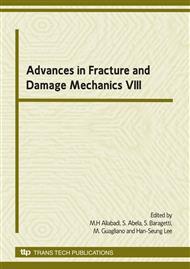p.793
p.797
p.801
p.805
p.809
p.813
p.817
p.821
p.825
On Crack Propagation of I-II Mixed Mode Fracture in Concrete by Means of Photoelastic Coatings
Abstract:
Investigation on crack propagation is important to understand mechanical behaviors and fracture mechanism in concrete. Till now substantial work has been done on crack propagation under mode-I loading, and mixed-mode fracture mechanics problems, however, are more common for actual crack growth. This study aims to systematically investigate the crack initiation, stable propagation and unstable failure of concrete under I-II mixed mode condition by using photoelasticity technique. For this purpose, reflective photoelastic coatings were applied to the surface of the four-point shearing notched concrete specimens with the maximum size of 2500mm×600mm×200mm. The resulting interference fringe on photoelastic coatings was recorded to reflect a complete crack propagation process. Based on the colored strain sequence, the strain profile around the crack tip could be determined and thereafter the load-crack extension curve. Then finite element analysis was performed to simulate the process of crack propagation and corresponding stress intensity factors were solved for every step. Experimental results show obvious stable crack propagation in concrete before unstable failure under I-II loading condition. The conventional failure criterion with the absence of this stable propagation quantity is therefore conservative. Besides, the fracture mode is ultimately I-mode even the specimen is subjected to I-II mixed mode loading condition, that is, the crack will extend in a direction perpendicular to the peak principal stress.
Info:
Periodical:
Pages:
809-812
Citation:
Online since:
October 2009
Authors:
Price:
Сopyright:
© 2010 Trans Tech Publications Ltd. All Rights Reserved
Share:
Citation:


